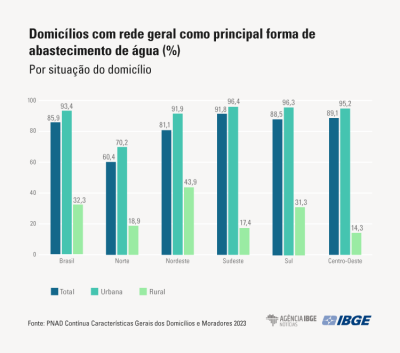Here is the rewritten HTML with new words, keeping the original names and removing external links except for embedded images and YouTube videos:
Water supply reaches 32.3% of rural homes in 2023
In 2023, 85.9% of homes had access to the general water supply network. In urban areas, this percentage was 93.4%, while in rural areas it was 32.3%. In all major regions, the main source of water supply was the general network, ranging from 60.4% in the North Region to 91.8% in the Southeast Region. Considering only rural areas, no region reached 50%, and the Northeast Region stood out with a percentage of 43.9% of homes with the general network as the main source of water supply. The information is from the Pnad Continuous: Characteristics of Homes and Residents, released today (20) by the IBGE.
“Historically, in the series of the survey, the percentage of rural homes in the Northeast Region with water supply through the general network has been higher than the rest of Brazil. In states such as Sergipe and Bahia, this proportion is above 50%. These percentages reflect the results of public policies implemented over the years to combat drought in the region, which take years to take effect,” notes William Kratochwill, analyst of the Pnad Continuous.
Among homes located in urban areas, it was observed that 93.4% had the general network as the main source of water supply in 2023, ranging from 70.2% in the North Region to 96.4% in the Southeast Region. With the exception of the North Region, in all other regions, more than 90% of urban homes had the general network as the main source of water supply.

Less than 10% of rural homes have access to the general sewage network
In 2023, 98.1% of homes in Brazil had a private bathroom, and in 69.9%, the sewage was disposed of through the general network or a septic tank connected to the general network. In urban areas, 99.4% of homes had a private bathroom, and 78.0% had access to the general sewage network.
Among rural homes, 88.4% had a private bathroom, while only 9.6% had the sewage disposed of through the general network or a septic tank connected to the general network.

Rural homes burn waste on their property
In 2023, 51.0% of rural homes burned waste on their property, followed by direct collection by a cleaning service (33.4%) and collection in a dumpster (10.9%).
Almost all homes have access to electricity, but alternative sources are still important
In 2023, 99.8% of homes had access to electricity, with 99.4% of homes receiving electricity from the general network, and availability in 98.7% of cases.
Most homes in Brazil have ceramic tile, concrete, or stone flooring
In 2023, 81.7% of homes used ceramic tile, concrete, or stone flooring, with 11.7% using cement, and 6.1% using wood suitable for construction. Other materials, including reclaimed wood, accounted for 0.6% of homes.
North Region has the lowest proportion of homes with walls made of concrete or stone
In 2023, 70.3% of homes in the North Region had walls made of concrete or stone, while in the Southeast Region, 94.6% of homes had walls made of concrete or stone.
More than half of homes in Brazil are owned and paid for
From 2016 to 2023, there was a continuous reduction in the percentage of homes owned and paid for, from 66.7% to 62.3%. During this period, the percentage of rented homes increased from 18.5% to 22.4%.
One in four homes has a motorcycle
In 2023, 48.1% of homes had a car, 24.6% had a motorcycle, and 12.6% had both. The South Region had the highest percentage of car ownership (67.5%), while the Northeast and North Regions had the lowest (27.6% and 30.6%, respectively). On the other hand, the Northeast and North Regions had the highest percentage of motorcycle ownership (35.4% and 32.6%, respectively), exceeding the percentage of car ownership in homes.
Older women are the majority among those living alone
The most common household arrangement was the nuclear family, which accounted for 65.9% of homes, but showed a decline from 2012 (68.3%). The nuclear family consists of a single nucleus formed by a couple, with or without children (including adopted and foster children) or stepchildren. Single-parent households, where the mother or father lives with children, are also considered nuclear.
More about the survey
The Pnad Continuous: Characteristics of Homes and Residents brings together information on the type and condition of occupation, predominant materials for walls, floors, and roofs, and services such as sanitation and electricity, as well as data on the characterization of homes.
Published originally by the IBGE News Agency on 20/12/2024 – 10:00
By Irene Gomes and Vinícius Britto – Social Statistics Editor
Art: Licia Rubinstein



